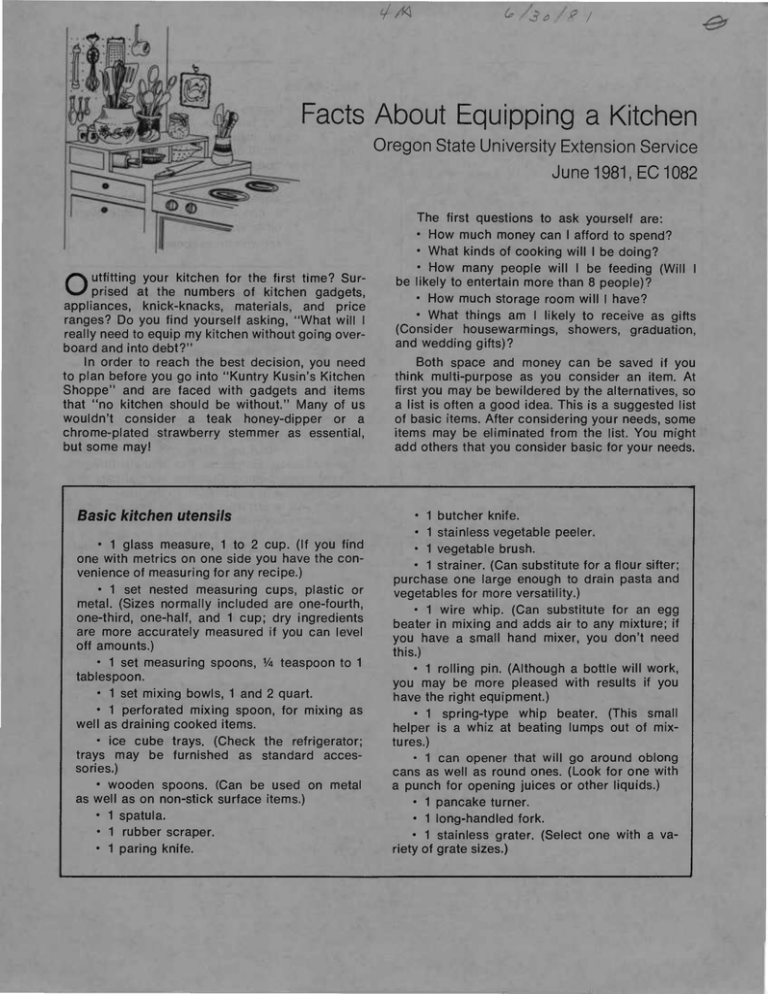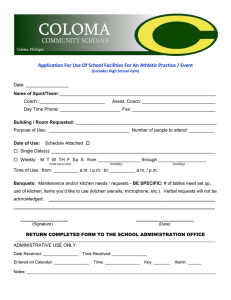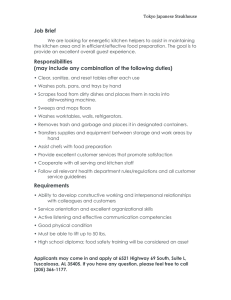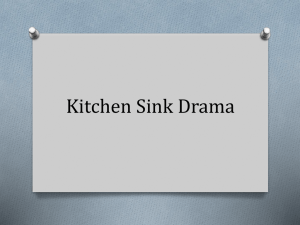Facts About Equipping a Kitchen ^ /3t/g / clM
advertisement

clM ^ /3t/g / Facts About Equipping a Kitchen Oregon State University Extension Service June 1981, EC1082 Outfitting your kitchen for the first time? Surprised at the numbers of kitchen gadgets, appliances, knick-knacks, materials, and price ranges? Do you find yourself asking, "What will I really need to equip my kitchen without going overboard and into debt?" In order to reach the best decision, you need to plan before you go into "Kuntry Kusin's Kitchen Shoppe" and are faced with gadgets and items that "no kitchen should be without." Many of us wouldn't consider a teak honey-dipper or a chrome-plated strawberry stemmer as essential, but some may! Basic kitchen utensils • 1 glass measure, 1 to 2 cup. (If you find one with metrics on one side you have the convenience of measuring for any recipe.) • 1 set nested measuring cups, plastic or metal. (Sizes normally included are one-fourth, one-third, one-half, and 1 cup; dry ingredients are more accurately measured if you can level off amounts.) • 1 set measuring spoons, V* teaspoon to 1 tablespoon. • 1 set mixing bowls, 1 and 2 quart. • 1 perforated mixing spoon, for mixing as well as draining cooked items. • ice cube trays. (Check the refrigerator; trays may be furnished as standard accessories.) • wooden spoons. (Can be used on metal as well as on non-stick surface items.) • 1 spatula. • 1 rubber scraper. • 1 paring knife. The first questions to ask yourself are: • How much money can I afford to spend? • What kinds of cooking will I be doing? • How many people will I be feeding (Will I be likely to entertain more than 8 people)? • How much storage room will I have? • What things am I likely to receive as gifts (Consider housewarmings, showers, graduation, and wedding gifts)? Both space and money can be saved if you think multi-purpose as you consider an item. At first you may be bewildered by the alternatives, so a list is often a good idea. This is a suggested list of basic items. After considering your needs, some items may be eliminated from the list. You might add others that you consider basic for your needs. • 1 butcher knife. • 1 stainless vegetable peeler. • 1 vegetable brush. • 1 strainer. (Can substitute for a flour sifter; purchase one large enough to drain pasta and vegetables for more versatility.) • 1 wire whip. (Can substitute for an egg beater in mixing and adds air to any mixture; if you have a small hand mixer, you don't need this.) • 1 rolling pin. (Although a bottle will work, you may be more pleased with results if you have the right equipment.) • 1 spring-type whip beater. (This small helper is a whiz at beating lumps out of mixtures.) • 1 can opener that will go around oblong cans as well as round ones. (Look for one with a punch for opening juices or other liquids.) • 1 pancake turner. • 1 long-handled fork. • 1 stainless grater. (Select one with a variety of grate sizes.) & Pots and pans Appliances • 1 fry pan, 8-inch, with cover. • 1 coffee pot or drip-filter system. • 1 tea kettle. (This is good for boiling and pouring water and many other uses.) • 1 double boiler. (Actually gives two separate saucepans with lid.) • 1 saucepan, 1 or 2 quart • 1 oblong cake or utility pan. (If you purchase one with a lid, you also have a cookie sheet; some come with removable rack converting to a broiler.) • 1 casserole with "pie pan" lid, 1 or 2 quart. If a range is furnished, it may come with a broiler pan and rack. As you think of a list of "soon to be added items," you might want to consider a large kettle for quantity cooking. Small appliances come in varieties that cook 1 hamburger, 12 hot dogs, or bacon only. You may not need many single-use appliances. Again, think multi-purpose. Three appliances that might be considered: • toaster oven. • electric skillet, 10- to 12-inch, with vented dome lid. (This can double as a portable oven and about 12 other appliances.) • hand mixer with three speeds. Miscellaneous • 1 dish drainer. • 1 set storage canisters. (Varying coffee can sizes work well.) • 1 waste basket with bin-type lid. (Lets you throw away trash with both hands full.) • 1 timer with audible ending. (Many kitchen ranges don't have a timing feature; you will find this a handy reminder for cooking, timing your exercises, or controlling telephone conversations.) When you purchase items, you will notice differences in quality and prices. Remember, you have decided how much you want to spend and that you are investing in tools of the trade. You may not need the most expensive brand name, but selecting items of good quality will give you more for your money and bring greater satisfaction as you use them. Look for securely attached handles that will not melt, metals that are firm and rust-proof, pans that are well-balanced with flat bottoms, labels that suggest proper use and care, and any statement of performance standards the manufacturer is willing to stand behind. Consider special care and upkeep of items in comparison to the use. When you return from shopping, remove labels or warranties from items. Mark the label with the store name and date of purchase; file these in a drawer or large marked envelope for future reference. Janice M. Weber former Extension family resource management specialist Oregon State University and Carolyn A. Raab Extension foods and nutrition specialist Oregon State University Extentlo* Sarvlc* O.agon Stat* Unhrarsity. Corvaliii, Manry duod ana d.unbut.d in turttwrmc* of Ih. Acti of CorgroM ol May • and Juna 30. 1914. Eitansion work is a coopenli.e pros am ot Oregon Slata Univaraity, tha U. S. Dapartmanl of Agriculture and Oregon counties. Eitansion in vil*i participation i i its program* and offara them aquallr to all people,




